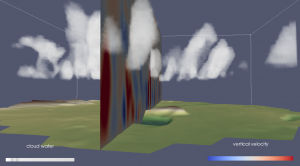Table of Contents
InScAPE Parameterization Testbed
Science objectives
A parameterization testbed is an environment where model and observational datastreams come together and can easily be inter-compared. The aim is to facilitate the parameterization evaluation and development process, by confronting models with data in a structural and informed manner. While such evaluation can give confidence in the realism of a model simulation, on the other hand the models can help to gain insight into processes as they act in nature, which are not yet fully understood. In this synergy, LES models act as virtual laboratory, Single-Column Model (SCM) simulations are used to better understand and improve parameterizations for GCMs, and GCM output is used to drive process models but also to act as background reference. A relatively new use of LES is to use its three-dimensional domain to virtually test measurement strategies a priori their deployment in the field during experiments.
The availability of long-term (i.e. multi-year) records of both measurements and model output is essential. Only then can statistical significance of the evaluation be ensured. Parameterization testbeds thus provide a “testing ground” for model development and evaluation, of larger-scale models but also of LES itself.
In practice the InScAPE testbed consists of a database of model simulations, a database of processed and quality checked observational products, and an interactive Graphical User Interface (GUI) to compare these datastreams. The InScAPE GUI can be found here. 
A brief history
The InScAPE parameterization testbed is a continuation of the KNMI Parameterization Testbed (KPT). The KPT was initiated and developed by Prof. Roel Neggers when affiliated at the KNMI in the period 2007-2013. What KPT and InScAPE share is the general modelling and evaluation strategy that is applied. Currently the InScAPE testbed includes simulations at and observational data from a number of meteorological supersites. The home site is the Jülich ObservatorY for Cloud Evolution (JOYCE) that is located at the Research Centre Jülich, and is operated by the research group of Prof.Susanne Crewell. Simulations are also performed at the Barbados Cloud Observatory (BCO), in order to study fast feedback mechanisms between subtropical marine boundary-layer clouds and the changing global climate. Recently the AWIPEV site at Ny Ålesund was added to the list of supersites, as part of our participation in the ongoing TR172 project on Arctic Amplification (AC)3. In the near future we also plan to perform simulations at the ARM SGP site, in collaboration with the ongoing LASSO initiative. 
Multi-year idealized DALES
Downscaling of a point-sampled profile from a GCM at a site of interest.
LES acts as a generator of high-frequency fine-scale variability around this larger-scale state.
Periodic lateral boundaries, homogeneous prescribed advective forcing.
These forcings have the shape of prescribed tendencies for the horizontal advection, and prescribed subsidence velocity for the vertical advection. As a result, the latter becomes interactive with vertical gradients as generated by the LES simulation.
Forcings and boundary conditions are based exclusively on ECMWF analyses and short-range (3hr) forecasts. Automated scripts have been developed to this purpose, and can be used to generate forcings at any location in the world, as far back in time as is covered by the MARS archive of IFS output.
DALES is equipped with a simplified version of the ECWMF surface and soil scheme, allowing simulation with evolving surface properties and interactive surface heat fluxes.
Domain size of 12.6×12.6x5km. Interactive radiation, using ECMWF state (including clouds) above the turbulent domain. Background ozone profile.
While simulations are simplified, it does make them more transparent and computationally efficient. A benefit of simplicity is the huge gain in time coverage that is allowed, allowing for multi-year simulation. Currently our database of DALES simulations covers five years of 6-month (April-September) periods from 2012 to 2016.
The database of idealized DALES simulations has been used in various studies. …
Recently the Inscape group is starting to experiment with blending observations from field campaigns with model-derived forcings for LES simulations. (NARVAL, ACLOUD, PASCAL)

ICON-LEM around supersites
 To follow up on the question how to compare best high-resolution simulations with observations and by this continue to create a database for parameterization development, we investigate high resolution simulations around sites with several measurement instruments. The ICON-LEM setup allows to have open boundaries and topography, both aspects are nice for simulating different synoptic situations. The simulations around the supersites are forced by a NWP model like the COSMO-DE or IFS, depending on availability. More information about the setup). So far we started simulations at the JOYCE supersite close to Jülich in North Rhine-Westfalia in Germany, the Zugspitze in the Alpes and Ny Ålesund at Spitsbergen.
To follow up on the question how to compare best high-resolution simulations with observations and by this continue to create a database for parameterization development, we investigate high resolution simulations around sites with several measurement instruments. The ICON-LEM setup allows to have open boundaries and topography, both aspects are nice for simulating different synoptic situations. The simulations around the supersites are forced by a NWP model like the COSMO-DE or IFS, depending on availability. More information about the setup). So far we started simulations at the JOYCE supersite close to Jülich in North Rhine-Westfalia in Germany, the Zugspitze in the Alpes and Ny Ålesund at Spitsbergen.
Basic quantities like the integrated water vapor are used to evaluate how well the model captures the mean weather state and follows the observed variability. The comparison and evaluation of the simulation with observations is ongoing work. Additionally the simulation output can be used for further research, including process understanding and testing of sensitivities.
